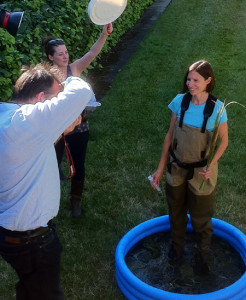WALNUT CREEK, Calif.—Susannah Green Tringe of the DOE Joint Genome Institute (DOE JGI) has been named one of 2011’s “Brilliant 10,” the annual list compiled by Popular Science magazine of top young researchers. In adding her name to the list, which appears in the October issue, the magazine recognized her $2.5 million grant from the DOE Early Career Research Program to study the role of microbial communities in restored wetlands in the San Francisco Bay-Delta region of California and their impact on long-term carbon sequestration.
The Popular Science Brilliant 10 recognizes scientists and researchers under the age of 40 who, according the magazine, “represent the best of what science can achieve and demonstrate American’s continuing cutting-edge research.” Nominations are solicited from hundreds of scientists and the list is whittled down, said Mark Jannot, editorial director, the Bonier Technology Group and Editor-in-Chief, PopularScience, to nominees “whose work really blows the tops of our heads off.”
The honor is the latest for the DOE JGI Metagenome Program lead. Tringe has been involved in several metagenomic studies, including the study of microbial communities in the termite hindgut, the leaf cutter ant and the cow rumen, as well as the microbial communities in ocean dead zones. Eddy Rubin, the DOE JGI Director, has worked with Tringe since 2003 when she was as a postdoctoral fellow in his laboratory at Lawrence Berkeley National Laboratory and has served as her mentor since she joined the DOE JGI in 2006. “Susannah is a terrific scientist. She has driven multiple important studies of environmental microbial communities and has helped establish the DOE JGI as a leader in the field of metagenomics.”
Tringe’s wetlands proposal was one of just 65 accepted out of more than 1,100 proposals submitted. Working with the U.S. Geological Survey, she has already started sampling at Twitchell Island, where, she said, the carbon sequestration rates in an experimental wetland restoration project are estimated to be “comparable to, if not greater than” the carbon sequestration rates achieved from tropical reforestation. Belowground microbes have the potential to both take up carbon or recycle it into the atmosphere, and thus are likely a major determinant of whether the wetland is a net source or sink for greenhouse gases.
The U.S. Department of Energy Joint Genome Institute, supported by the DOE Office of Science, is committed to advancing genomics in support of DOE missions related to clean energy generation and environmental characterization and cleanup. DOE JGI, headquartered in Walnut Creek, Calif., provides integrated high-throughput sequencing and computational analysis that enable systems-based scientific approaches to these challenges. Follow DOE JGI on Twitter.
